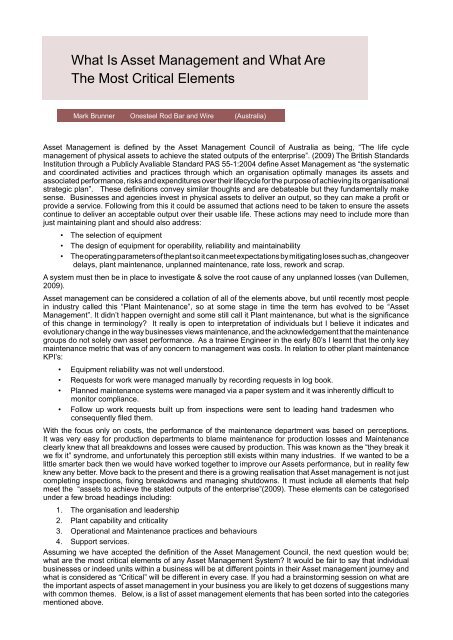SKF Reliability Systems - Library
SKF Reliability Systems - Library
SKF Reliability Systems - Library
Create successful ePaper yourself
Turn your PDF publications into a flip-book with our unique Google optimized e-Paper software.
What Is Asset Management and What Are<br />
The Most Critical Elements<br />
Mark Brunner Onesteel Rod Bar and Wire (Australia)<br />
Asset Management is defined by the Asset Management Council of Australia as being, “The life cycle<br />
management of physical assets to achieve the stated outputs of the enterprise”. (2009) The British Standards<br />
Institution through a Publicly Avaliable Standard PAS 55-1:2004 define Asset Management as “the systematic<br />
and coordinated activities and practices through which an organisation optimally manages its assets and<br />
associated performance, risks and expenditures over their lifecycle for the purpose of achieving its organisational<br />
strategic plan”. These definitions convey similar thoughts and are debateable but they fundamentally make<br />
sense. Businesses and agencies invest in physical assets to deliver an output, so they can make a profit or<br />
provide a service. Following from this it could be assumed that actions need to be taken to ensure the assets<br />
continue to deliver an acceptable output over their usable life. These actions may need to include more than<br />
just maintaining plant and should also address:<br />
• The selection of equipment<br />
• The design of equipment for operability, reliability and maintainability<br />
• The operating parameters of the plant so it can meet expectations by mitigating loses such as, changeover<br />
delays, plant maintenance, unplanned maintenance, rate loss, rework and scrap.<br />
A system must then be in place to investigate & solve the root cause of any unplanned losses (van Dullemen,<br />
2009).<br />
Asset management can be considered a collation of all of the elements above, but until recently most people<br />
in industry called this “Plant Maintenance”, so at some stage in time the term has evolved to be “Asset<br />
Management”. It didn’t happen overnight and some still call it Plant maintenance, but what is the significance<br />
of this change in terminology? It really is open to interpretation of individuals but I believe it indicates and<br />
evolutionary change in the way businesses views maintenance, and the acknowledgement that the maintenance<br />
groups do not solely own asset performance. As a trainee Engineer in the early 80’s I learnt that the only key<br />
maintenance metric that was of any concern to management was costs. In relation to other plant maintenance<br />
KPI’s:<br />
• Equipment reliability was not well understood.<br />
• Requests for work were managed manually by recording requests in log book.<br />
• Planned maintenance systems were managed via a paper system and it was inherently difficult to<br />
monitor compliance.<br />
• Follow up work requests built up from inspections were sent to leading hand tradesmen who<br />
consequently filed them.<br />
With the focus only on costs, the performance of the maintenance department was based on perceptions.<br />
It was very easy for production departments to blame maintenance for production losses and Maintenance<br />
clearly knew that all breakdowns and losses were caused by production. This was known as the “they break it<br />
we fix it” syndrome, and unfortunately this perception still exists within many industries. If we wanted to be a<br />
little smarter back then we would have worked together to improve our Assets performance, but in reality few<br />
knew any better. Move back to the present and there is a growing realisation that Asset management is not just<br />
completing inspections, fixing breakdowns and managing shutdowns. It must include all elements that help<br />
meet the “assets to achieve the stated outputs of the enterprise”(2009). These elements can be categorised<br />
under a few broad headings including:<br />
1. The organisation and leadership<br />
2. Plant capability and criticality<br />
3. Operational and Maintenance practices and behaviours<br />
4. Support services.<br />
Assuming we have accepted the definition of the Asset Management Council, the next question would be;<br />
what are the most critical elements of any Asset Management System? It would be fair to say that individual<br />
businesses or indeed units within a business will be at different points in their Asset management journey and<br />
what is considered as “Critical” will be different in every case. If you had a brainstorming session on what are<br />
the important aspects of asset management in your business you are likely to get dozens of suggestions many<br />
with common themes. Below, is a list of asset management elements that has been sorted into the categories<br />
mentioned above.

















